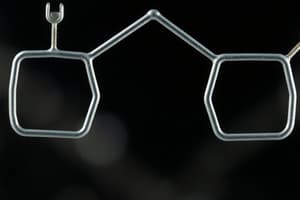Podcast
Questions and Answers
What is the general formula for aldehydes and ketones, respectively?
What is the general formula for aldehydes and ketones, respectively?
RCHO for aldehydes and RCOR’ for ketones
What is the primary difference in the structure of aldehydes and ketones?
What is the primary difference in the structure of aldehydes and ketones?
In aldehydes, the carbonyl group is attached to an alkyl group and a hydrogen atom, while in ketones, it is attached to two alkyl groups.
How do the common names of aldehydes relate to the names of corresponding carboxylic acids?
How do the common names of aldehydes relate to the names of corresponding carboxylic acids?
The common names of aldehydes are derived from the names of corresponding carboxylic acids by replacing –ic acid with –aldehyde.
What is the characteristic reaction of carbonyl compounds, such as aldehydes and ketones?
What is the characteristic reaction of carbonyl compounds, such as aldehydes and ketones?
Why are aldehydes more easily oxidized than ketones?
Why are aldehydes more easily oxidized than ketones?
What is the functional group present in both aldehydes and ketones?
What is the functional group present in both aldehydes and ketones?
What is the common feature among the derivatives mentioned in the text?
What is the common feature among the derivatives mentioned in the text?
What is the general formula for ethers?
What is the general formula for ethers?
What is the role of citric acid and benzoic acid in food products?
What is the role of citric acid and benzoic acid in food products?
What is the purpose of ethylenediaminetetraacetic acid (EDTA) in various applications?
What is the purpose of ethylenediaminetetraacetic acid (EDTA) in various applications?
What is the difference between a symmetrical and an unsymmetrical ether?
What is the difference between a symmetrical and an unsymmetrical ether?
What is the general formula for ethers?
What is the general formula for ethers?
What is the IUPAC prefix name for an ether, and how is it determined?
What is the IUPAC prefix name for an ether, and how is it determined?
How are alkyl groups numbered in IUPAC naming of ethers?
How are alkyl groups numbered in IUPAC naming of ethers?
What is the use of Methyl Tertiary Butyl Ether (MTBE) mentioned in the text?
What is the use of Methyl Tertiary Butyl Ether (MTBE) mentioned in the text?
What are some of the industries that utilize ethers?
What are some of the industries that utilize ethers?
What is the suffix for the alkoxy substituent in IUPAC naming of ethers?
What is the suffix for the alkoxy substituent in IUPAC naming of ethers?
How are common names for ethers determined?
How are common names for ethers determined?
What is the solubility trend of carboxylic acids based on the length of their alkyl chain?
What is the solubility trend of carboxylic acids based on the length of their alkyl chain?
Why do carboxylic acids tend to have higher boiling points than water?
Why do carboxylic acids tend to have higher boiling points than water?
What is the characteristic of the odor of carboxylic acids?
What is the characteristic of the odor of carboxylic acids?
What is the main difference between saturated and unsaturated aliphatic acids?
What is the main difference between saturated and unsaturated aliphatic acids?
What type of carboxylic acid has a COOH group bonded to an aromatic benzene ring?
What type of carboxylic acid has a COOH group bonded to an aromatic benzene ring?
What is the characteristic of polycarboxylic acids?
What is the characteristic of polycarboxylic acids?
What is the main reason why primary amides have the highest melting point compared to secondary and tertiary amides?
What is the main reason why primary amides have the highest melting point compared to secondary and tertiary amides?
What is the reagent used to reduce amides to primary amines?
What is the reagent used to reduce amides to primary amines?
What is the product of the hydrolysis of ethanamide under acidic conditions?
What is the product of the hydrolysis of ethanamide under acidic conditions?
What is the name of the reaction in which a primary amide is converted to a primary amine with one fewer carbon atom?
What is the name of the reaction in which a primary amide is converted to a primary amine with one fewer carbon atom?
How are amides dehydrated?
How are amides dehydrated?
Why are small amides soluble in water?
Why are small amides soluble in water?
Flashcards are hidden until you start studying
Study Notes
Aldehydes and Ketones
- Aldehydes have the general formula RCHO; ketones have RCOR'.
- Both contain the carbonyl group (C=O), termed carbonyl compounds.
- In aldehydes, the carbonyl is bound to one hydrogen and one alkyl group; in ketones, it is linked to two alkyl groups.
- Aldehydes are easily oxidized; ketones are oxidized with difficulty.
- Aldehydes typically show greater reactivity towards nucleophilic addition compared to ketones.
Nomenclature and Structure of Aldehydes
- Aldehyde common names derive from carboxylic acids by altering the suffix from “-ic acid” to “-aldehyde.”
- Branched-chain aldehydes are named as derivatives of straight-chain aldehydes.
- Greek letters (α, β) indicate attachment points for branches in derivatives.
- Examples:
- HCHO is formaldehyde (methanol)
- CH3CHO is acetaldehyde (ethanol)
- CH3CH2CH2CHCHO is α-methylaldehyde (2-methylpentanal).
Uses of Aldehydes
- Utilized in producing polymers (dyestuffs, perfumes, rayon).
- Serve as solvents in pharmaceuticals.
- Employed as food additives like acetic acid and as preservatives such as citric and benzoic acids.
- Act as chelating agents, exemplified by ethylenediaminetetraacetic acid.
Ethers
- Ethers consist of an oxygen atom connected to two alkyl groups, with the formula R-O-R'.
- They are utilized in dyes, perfumes, oils, and waxes.
Nomenclature and Structure of Ethers
- Ethers are named as alkoxy alkanes, indicating the longest alkyl group as the parent.
- Common names for ethers are derived by listing alkyl groups alphabetically followed by "ether."
- Identical alkyl groups lead to symmetrical ethers; different groups yield unsymmetrical ethers.
- Example: Ethyl pentyl ether is known as ethoxypentane.
Physical Properties of Carboxylic Acids
- Small carboxylic acids (1 to 5 carbons) are soluble in water; larger acids exhibit limited solubility.
- Physical Properties Table highlights melting points, boiling points, and solubility for various acids.
Acidic Nature of Carboxylic Acids
- Carboxylic acids are classified as weak acids, not fully ionizing in water.
- They typically have higher boiling points than water due to larger surface areas.
- Characterized by strong sour odors.
- Classification includes:
- Saturated aliphatic acids (e.g., formic acid - ant venom, acetic acid - vinegar).
- Unsaturated aliphatic acids (compounds with C=C double bonds).
- Aromatic acids (COOH group adhered to benzene).
- Polycarboxylic acids (chains with multiple COOH groups).
Physical Properties and Chemistry of Amides
- Amides are less basic than amines; mostly solids except for ethanamide, which is liquid at room temperature.
- Melting point order is Primary > Secondary > Tertiary, with primary amides forming the most hydrogen bonds.
- Small amides are water-soluble due to hydrogen bonding potential.
Important Amide Reactions
- Amides can convert to primary amines via reduction with lithium tetrahydridoaluminate (LiAlH4) in dry ether.
- Hydrolysis of amides occurs with water and dilute acid, yielding corresponding carboxylic acids.
- The Hofmann rearrangement transforms primary amides into primary amines with fewer carbon atoms.
- Heating amides with phosphorus(V) oxide leads to dehydration reactions.
Studying That Suits You
Use AI to generate personalized quizzes and flashcards to suit your learning preferences.





